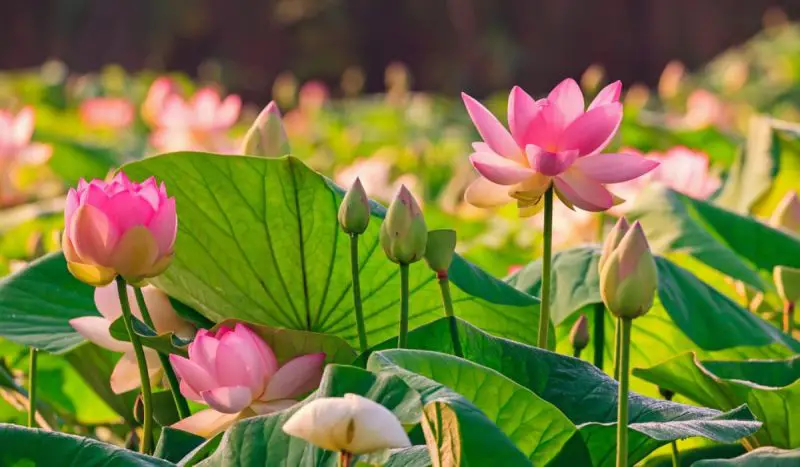Lotus flowers are iconic aquatic plants known for their beauty, symbolism, and cultural significance. They thrive in calm, shallow waters and are often associated with purity, enlightenment, and resilience. Understanding where lotus flowers grow is crucial for gardeners, botanists, and nature enthusiasts. Planting and maintaining lotus requires knowledge of their natural habitats, water conditions, and climate preferences.
Lotus flowers are native to diverse regions across Asia, Australia, and North America. They can adapt to tropical, subtropical, and temperate climates when conditions are favorable. By studying their natural environments, gardeners can replicate similar conditions in ponds or water gardens. This guide explores lotus habitats, environmental needs, propagation methods, and care tips to ensure vibrant growth and blooming throughout the season.
Historical and Cultural Significance of Lotus

The lotus flower has held profound symbolism for thousands of years across various cultures. In Asia, it is revered in Hinduism and Buddhism as a symbol of purity, enlightenment, and spiritual awakening. Its ability to bloom beautifully from muddy waters represents resilience, renewal, and transcendence over adversity. Lotus motifs appear widely in ancient art, architecture, and religious ceremonies, reflecting its deep cultural significance.
Beyond spiritual symbolism, lotus flowers also played practical roles in daily life. In ancient China and India, lotus seeds and roots were used as food, while petals and leaves served medicinal purposes. Gardens and temples often incorporated lotus ponds, creating serene environments for meditation and reflection. This blend of aesthetic, spiritual, and practical value highlights the lotus’s enduring importance across history.
Common Lotus Species and Varieties
Sacred Lotus (Nelumbo nucifera)
The sacred lotus, Nelumbo nucifera, is native to Asia and is the most culturally significant lotus species. It grows in shallow ponds, lakes, and slow-moving rivers, thriving in warm, humid climates. This species is known for its large, fragrant flowers that range from pink to white and can reach up to 12 inches in diameter. Its leaves are broad, circular, and water-repellent, creating a striking visual display in aquatic environments.
Sacred lotus has strong symbolic importance in Hinduism and Buddhism, often representing purity, spiritual awakening, and enlightenment. Gardeners value this species for its resilience, long blooming period, and ability to adapt to artificial ponds and water gardens. Proper sunlight, water depth, and nutrient-rich soil are essential for maintaining healthy growth and vibrant flowers.
American Lotus (Nelumbo lutea)
The American lotus, Nelumbo lutea, is native to North America, primarily found in wetlands, ponds, and slow-moving rivers. It produces pale yellow flowers and large, circular leaves that float on the water’s surface. This species prefers full sun and slightly deeper water compared to the sacred lotus, making it adaptable to different garden ponds.
Nelumbo lutea plays an ecological role, providing habitat and food for aquatic wildlife. Gardeners appreciate its hardiness and ornamental value, especially for naturalistic water gardens. Proper planting techniques, including adequate spacing, nutrient-rich soil, and water management, help ensure healthy growth and abundant blooms throughout the season.
Natural Habitats of Lotus Flowers
Lotus in Asia
Asia is home to the majority of lotus species, particularly the sacred lotus, Nelumbo nucifera. These plants thrive in countries such as India, China, Japan, and Thailand, where warm, humid climates provide ideal growing conditions. Lotus flowers grow in shallow ponds, rivers, and marshes with still or slow-moving water. The rich organic sediment at the bottom of these water bodies supplies essential nutrients for growth.
Lotus plants require full sun to produce vibrant flowers. Seasonal monsoons in many Asian regions provide adequate water levels and support robust growth. Lotus also play a significant cultural role in Asian traditions, appearing in art, literature, and religious symbolism. Understanding these natural habitats helps gardeners recreate similar conditions in artificial ponds and water gardens, ensuring healthy growth and stunning blooms.
Lotus in Australia
Lotus species are found across northern and eastern Australia, where tropical and subtropical climates prevail. Shallow lakes, wetlands, and man-made reservoirs provide suitable conditions for growth. Australian lotus plants adapt to varying water levels, making them resilient in environments with fluctuating rainfall. Nutrient-rich mud at the pond bottom supports healthy roots and promotes vibrant flowering.
These plants often coexist with native aquatic species, providing shelter and food for fish and insects. Full sunlight is essential for photosynthesis and flowering, while moderate temperatures prevent stress during the growing season. Gardeners can replicate Australian conditions by maintaining stable water levels, using nutrient-rich substrates, and ensuring ample sunlight. Understanding regional adaptation is key to successful cultivation outside natural habitats.
Lotus in North America
In North America, lotus flowers are primarily found in the southern United States, including Louisiana, Texas, and Florida. Wetlands, slow-moving rivers, and shallow ponds offer ideal conditions for lotus growth. Warm, humid summers and mild winters support perennial growth and abundant blooms. The rich, muddy bottoms of these water bodies supply necessary nutrients.
Lotus plants in North America often share habitats with water lilies, cattails, and other aquatic species, creating a balanced ecosystem. Gardeners can replicate these environments by selecting ponds with full sun exposure, maintaining shallow water levels, and enriching the soil with organic matter. Observing native growth patterns allows for more effective cultivation and long-lasting blooms.
Environmental Requirements for Lotus Growth
Sunlight and Temperature Needs
Lotus flowers require full sun to thrive, ideally six to eight hours of direct sunlight daily. Sunlight stimulates flowering and strengthens stems and leaves. Temperature plays a vital role; lotus prefer warm conditions, with water temperatures between 75–87°F (24–31°C) being optimal for growth. Cold temperatures can slow growth or halt flowering entirely.
In tropical regions, consistent sunlight ensures robust foliage and vibrant blooms. Gardeners in temperate climates should position lotus in areas that receive maximum sun exposure. Protecting lotus from frost or sudden temperature drops is essential, as cold stress can damage rhizomes and reduce flowering potential. Understanding sunlight and temperature requirements is key to replicating natural conditions successfully.
Water Depth and Quality
Lotus flowers thrive in shallow water, typically 2–12 inches above the soil surface for young plants, and up to 24 inches for mature specimens. Water depth affects rhizome stability, leaf development, and flower emergence. Stagnant or slow-moving water replicates natural pond habitats, allowing lotus to anchor roots effectively.
Water quality is equally important. Lotus prefer nutrient-rich, slightly acidic to neutral water with minimal pollutants. Excessive chemicals or poor drainage can stunt growth or prevent blooming. Maintaining water clarity and monitoring nutrient levels supports healthy foliage and vibrant flowers. Gardeners can use pond liners, organic fertilizers, and regular water changes to create ideal conditions similar to natural habitats.
Soil Composition
Lotus flowers grow best in rich, loamy soil with high organic content. Muddy pond bottoms provide essential nutrients and support strong rhizome development. Heavy clay or silt soils retain moisture and supply minerals, while sandy soils may require amendments to improve fertility and structure.
Adding compost or decomposed organic matter enhances nutrient availability and mimics natural wetland conditions. Avoid commercial potting mixes with high peat content, as they may float and destabilize roots. Healthy soil promotes vigorous growth, lush foliage, and abundant flowering. Replicating the soil composition found in natural habitats is critical for successful lotus cultivation in artificial ponds or containers.
Seasonal Growth and Blooming Patterns
Lotus flowers follow distinct seasonal growth cycles that vary by species and climate. In spring, rhizomes break dormancy, producing new roots and emerging leaves. Early leaves float on the water surface, gradually expanding as temperatures rise. This initial growth phase is crucial for establishing a strong foundation for healthy blooms later in the season.
By summer, lotus plants enter their peak flowering period. Large, vibrant flowers emerge above the water, attracting pollinators such as bees and butterflies. Flowering may continue for several weeks, with individual blooms lasting only a few days, but new buds form continuously. Regular sunlight, stable water levels, and proper fertilization are essential to maintain this rhythm.
As temperatures cool in fall, lotus plants begin to slow growth and prepare for dormancy. Leaves and flowers naturally wither, and energy is stored in the rhizomes to survive winter. Gardeners should remove decayed foliage and apply protective mulch to ensure rhizomes remain healthy. Understanding these seasonal patterns helps predict flowering times and ensures successful cultivation year after year.
Propagation Methods
Propagation by Seeds
Lotus flowers can be propagated from seeds, which require careful preparation. Scarifying the seed coat and soaking in warm water for 24–48 hours encourages germination. Seeds should then be planted in shallow water with nutrient-rich soil. Seed propagation allows gardeners to grow new plants from unique genetic lines, but it may take longer to produce blooms compared to rhizome propagation.
Monitoring water temperature and depth is essential during germination. Seedlings require steady sunlight and stable water conditions for healthy root and leaf development. Patience is necessary, as flowers may take several months or even a full growing season to emerge. Seed propagation is ideal for experimentation and expanding lotus collections naturally.
Propagation by Rhizomes
Rhizome division is the fastest and most reliable method for propagating lotus. Healthy rhizomes with visible growth nodes can be separated from the parent plant and replanted in shallow, nutrient-rich soil. This method produces mature plants capable of flowering in the first season.
Handling rhizomes carefully is important to avoid damage. Planting in stable water conditions and providing adequate sunlight ensures rapid establishment. Rhizome propagation preserves the characteristics of the parent plant, making it ideal for gardeners seeking consistent flower color, size, and form. Regular care and monitoring support strong root development and abundant blooms.
Care and Maintenance
Fertilization Practices
Fertilizing lotus plants is essential for lush foliage and vibrant flowers. Use slow-release aquatic fertilizers or organic options such as composted manure. Fertilization should occur during active growth, typically in spring and summer. Over-fertilization can harm plants and water quality, so careful dosing is important.
Proper fertilization strengthens rhizomes, promotes multiple blooms, and enhances leaf size. Nutrient-rich conditions replicate natural habitats, supporting healthy growth and flowering. Monitoring soil and water nutrient levels helps prevent deficiencies and ensures optimal performance. Balanced fertilization is a cornerstone of successful lotus cultivation.
Pest and Disease Control
Lotus flowers are generally resilient but can be affected by aphids, caterpillars, and fungal diseases. Regular inspection of leaves, stems, and flowers allows early detection of pests. Organic solutions, such as neem oil or insecticidal soap, are effective for minor infestations without harming pollinators.
Fungal issues, such as leaf spot or root rot, often occur in stagnant or overcrowded conditions. Maintaining proper spacing, adequate sunlight, and good water circulation reduces disease risk. Healthy plants are more resistant to pests and pathogens. Consistent care, monitoring, and preventive measures help lotus maintain vibrant blooms and strong foliage throughout the growing season.
Pruning and Deadheading
Pruning spent leaves and flowers encourages continuous growth and prevents decay in lotus plants. Deadheading old blooms redirects energy to new flower production and keeps the plant visually appealing. Trim damaged or yellowing leaves to reduce disease risk and maintain healthy foliage.
Regular maintenance mimics natural processes observed in wild habitats. Removing debris and thinning crowded leaves improves airflow and light penetration. Careful pruning enhances bloom frequency, strengthens stems, and promotes overall plant vigor. Well-maintained lotus plants remain productive and visually striking in any garden or pond setting.
Water Garden Design with Lotus
Designing a water garden with lotus flowers requires careful planning to replicate their natural habitat. Lotus thrive in shallow, calm water, so selecting a pond or container with stable water levels is essential. Ensure the pond has nutrient-rich soil or a clay-based substrate to support strong rhizome growth and abundant blooms. Position the lotus where it will receive full sunlight for at least six hours daily to promote vibrant flowers and healthy foliage.
Integrating lotus with other aquatic plants enhances both aesthetics and ecological balance. Plants such as water lilies, marginal grasses, and floating ferns complement lotus visually and provide shelter for fish and beneficial insects. Avoid overcrowding to maintain proper water circulation, reduce disease risk, and allow each plant enough space to grow.
Regular maintenance, including fertilization, pruning, and debris removal, ensures the pond remains healthy and visually appealing. Thoughtful design not only highlights the lotus’s beauty but also creates a serene, naturalistic environment. A well-planned water garden encourages continuous growth, vibrant blooms, and a tranquil space for relaxation and wildlife observation.
Common Mistakes When Growing Lotus
Planting Too Deep or Shallow
One common mistake is planting lotus rhizomes at the wrong depth. Young lotus plants should be in shallow water, 2–12 inches above soil, while mature plants can tolerate 12–24 inches. Planting too deep can prevent leaves and flowers from reaching the surface, reducing blooming. Shallow planting may expose rhizomes to drying or damage during hot weather.
Proper planting depth ensures stable root development and supports strong, healthy growth. Gardeners should monitor water levels regularly, especially in artificial ponds, and adjust depth as plants mature. Correct planting replicates natural habitats, promoting vigorous growth and abundant flowering.
Neglecting Sunlight, Water, and Nutrients
Another frequent error is insufficient sunlight, poor water quality, or improper fertilization. Lotus require full sun for at least six hours daily to bloom well. Stagnant or nutrient-poor water can stunt growth, while over-fertilization may harm plants or algae balance.
Maintaining nutrient-rich soil, stable water conditions, and proper sunlight exposure is crucial. Regular monitoring, careful fertilization, and adequate spacing prevent disease and support long-lasting blooms. Avoiding these mistakes ensures healthy, vibrant lotus plants that flourish season after season.
FAQ About Where to Grow Lotus Flowers
How do I know if my lotus plant is healthy?
A healthy lotus has vibrant green leaves, strong stems, and visible growth nodes on the rhizome. Flowers should bloom fully, and new leaves should emerge regularly. Yellowing leaves, stunted growth, or rotting rhizomes indicate issues with water quality, sunlight, or nutrients. Regular inspection helps detect problems early and ensures vigorous growth.
What is the ideal water depth for lotus growth?
Lotus thrives in shallow water, generally 2–12 inches above soil for young plants and up to 24 inches for mature specimens. Proper depth ensures rhizomes anchor firmly while leaves and flowers float above the water. Water that is too deep or shallow can stunt growth, reduce flowering, or cause rhizome instability.
How often should I fertilize lotus plants?
Fertilization is essential during the growing season, typically spring through summer. Use slow-release aquatic fertilizer or organic compost to provide nutrients. Apply fertilizers carefully to avoid overfeeding, which can harm plants and water quality. Well-nourished lotus produce larger leaves, stronger stems, and more vibrant blooms.
Can lotus survive winter in colder climates?
Yes, most lotus species are hardy perennials, but protection is necessary in cold climates. After the first frost, cut back stems and remove dead foliage. Apply a thick mulch to insulate rhizomes. Container-grown lotus should be moved to a frost-free area or greenhouse to prevent root damage.
How can I prevent common lotus diseases and pests?
Proper spacing, full sunlight, and good water circulation reduce fungal diseases like leaf spot and root rot. Inspect plants regularly for pests such as aphids or caterpillars. Organic treatments like neem oil or insecticidal soap control infestations without harming pollinators. Maintaining healthy conditions ensures robust growth and continuous flowering.
Conclusion
Understanding where lotus flowers grow and their natural habitats is key to successful cultivation. Thriving in shallow, nutrient-rich waters with full sun, lotus plants reward careful care with vibrant blooms and lush foliage. By replicating sunlight, water, soil, and seasonal conditions, gardeners can enjoy healthy, resilient plants year after year. Proper propagation, fertilization, pest management, and winter preparation ensure continuous growth and flowering. Embracing these practices transforms any pond or water garden into a serene, colorful sanctuary filled with timeless beauty.






